Rudolf Zeilinger represents a living link to one of the all-time greats of dressage, his mentor, Willi Schultheis. Rudolf has been a hugely successful competitor in his own right, and a highly successful trainer of international riders and teams.
Chris Hector interviewed Rudolf Zielinger in 2012 at a demonstration at Boneo Park. Ros Neave took the pix.
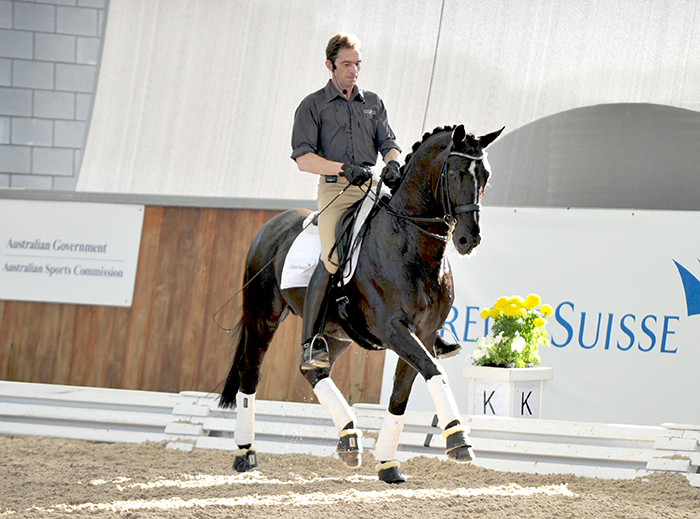
Guess what Mr Zeilinger reckons dressage is all about?
It’s that boring old training scale again: Rhythm, Relaxation, Impulsion, Straightness, Collection. And how do you achieve these qualities? With the first horse, he worked on response to the aids:
“You don’t need your leg, he should react to your seat bones – if he doesn’t, then use your legs. Forward and back, soft hands, just with your seat. Now the horse is much more uphill, much more in self carriage.”
“We have the horse more sensitive, more listening to your legs. That is what we want every working session, the horse more focused on the rider. Not just going round and round, get the transitions, get the horse listening, and the transitions will make the horse more athletic, they will build the muscles and the power from behind.
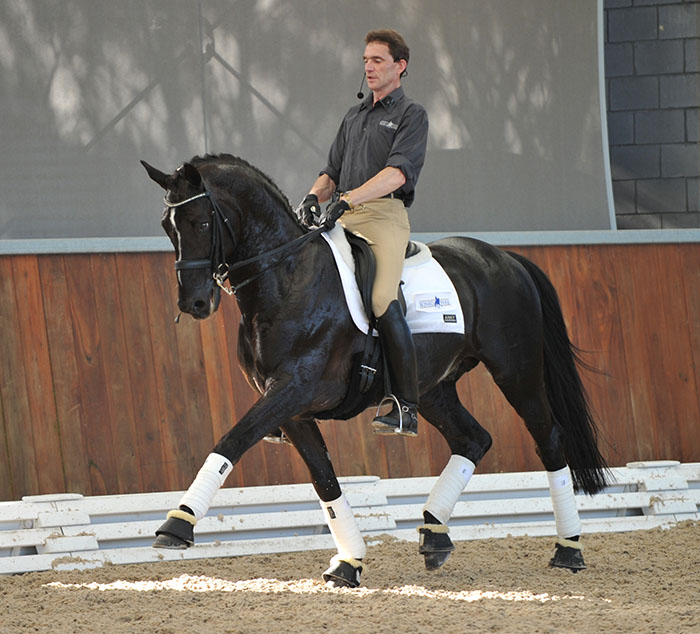
It’s a bit like that old Pete Seeger song, When will they ever learn… Top professionals regularly fetch up in Australia, and they are all singing from the same hymn book, you must work on your basics, but we can see by what happens in the competition arena, the riders are not listening. Rudolf worked with a series of riders and horses of different ages and levels, and while the basic principles remained the same, the application differed from horse to horse, Rudolf told the audience:
“The first horse was very steady in the contact, maybe too strong, so we work to get it loose.”
“With the second horse, we had to look first to establish the connection. People ask me, how much can you do with a five or six or seven-year-old – the horses will tell you what they are able to do. With the five and six-year-old horse, you should play with different things, always have in the back of your mind, in four or five years we will need piaffe ready at a high level. That is horsemanship, not thinking, oh my horse has done Prix St Georges, now I will teach piaffe so we can do Grand Prix next season. Go into the horse, and find out what is possible – play and give yourself enough time to be fair to the horse.”
And if Rudolf spent time with one horse developing a more uphill outline, with the the next, it was the reverse, stressing that you can’t train a horse in a competition frame: “let him out, not short in the neck, let him be supple.”
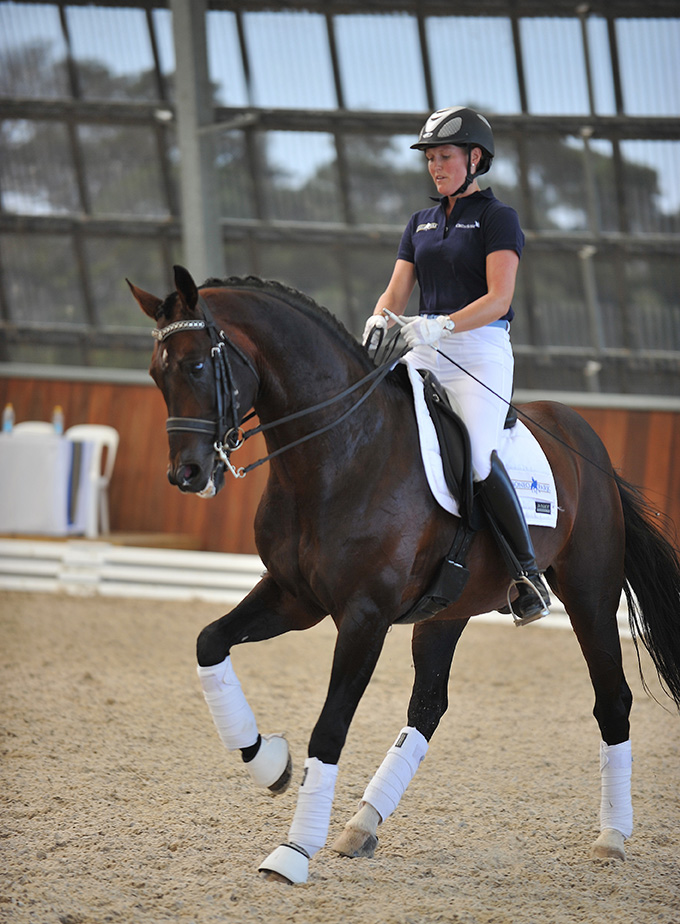
“Come here, let me loosen the curb chain, I think that will be better. Riders start to think training a half pass for a nine, but you have to develop a half pass at the highest level. Maybe you ride a half pass with no bend to develop the crossing of the legs, or even a half pass bent to the other side. You don’t ride a half pass like you would in a perfect test from the beginning.”
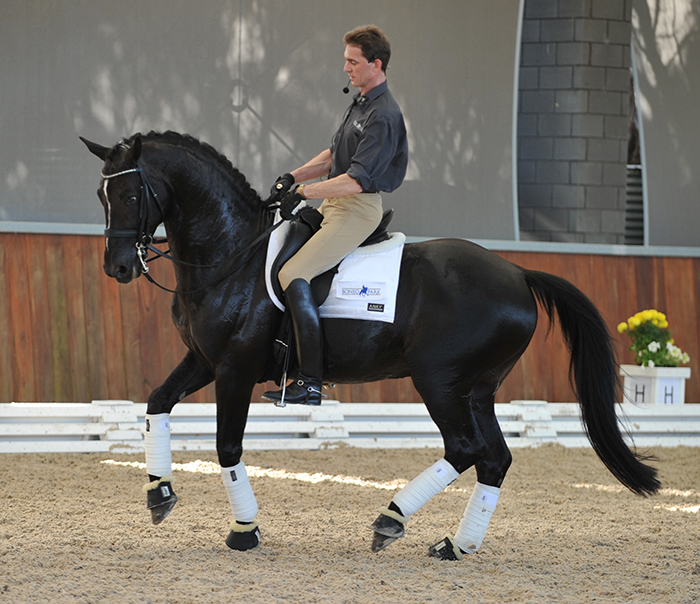
On to the half steps…
“Have the neck lower and longer in training. Don’t stress the horse, don’t try to do 200 steps, five steps bending the horse with low hands is fine at the beginning. Not too much leg, use your seat. He’s in the right rhythm for piaffe, and moving diagonally. Stay on a small circle and let him open up his back. Move out in a supple trot. Also in canter, soft and let him out, not short in the neck.”
There were no surprises in Rudolf’s display, we saw a horse that had been properly educated in the basics finding it quite easy to respond to the aids of a strange rider: that really was the aim of dressage, to produce a horse that any educated horseman could get on and enjoy the ride.
Note – the horse Rudolf rode was OO7
next we ask Rudlolf about his trainers…
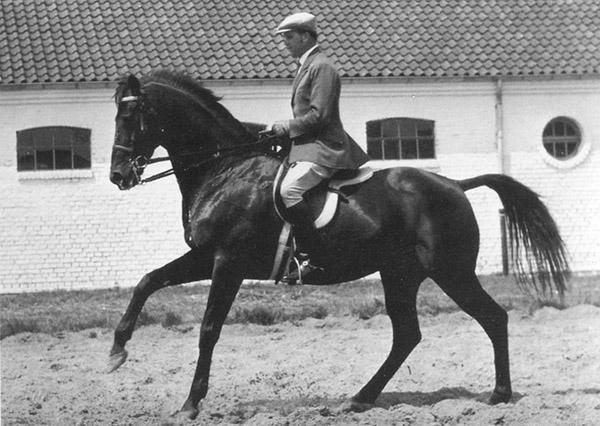
Willi Schultheis and the Thoroughbred Chronist
Rudolf is a legend in his own lifetime, as a competitor and a trainer, but he is also the best known graduate of the school of one of the great trainers of all time, Willi Schultheis… But his story started before that, as the son of pony breeders:
“I started riding ponies from the same time as I started walking, it was only for fun, my parents were pony breeders. My real riding career I started when I was 16 or 17 years old with a German bereiter education. After two years, I had the big possibility to move to Willi Schultheis and so all my dressage knowledge and career really started. I must say he was my big mentor and it’s built from him. I spent ten years with him and then during the last three or four years with him I also did my own business with 15 horses in training. In 1992 I finished working with Willi Schultheis and made my own business, and then from there on it grew up from 25 horses to now having 40 horses in my stable in training. Now I have my own place, my own training facility with two big indoor riding arenas.”
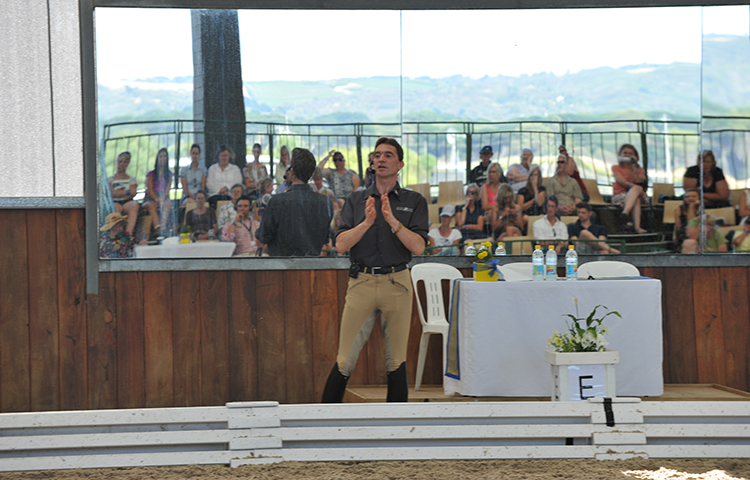
Thinking back to Mr Schultheis, what would you say was the essence, what’s the main thing of his way of training and riding horses?
“He was a natural artist/talent. His way of riding was more art than a craftsman. He had a big feeling to think very quickly into a horse, to see what is the point, the problems there. The great thing was through the influence of his riding, he could moderate almost all horses to work on his side. He loved especially the Thoroughbred or Trakehner horses, horses that were a little bit more hot in their temperament. But remember that our Warmbloods are much more different to the horses they were riding in the 60s or 70s. Our breeding now is so much influenced with the Thoroughbreds and much lighter and more refined than the warmblood horses then.”
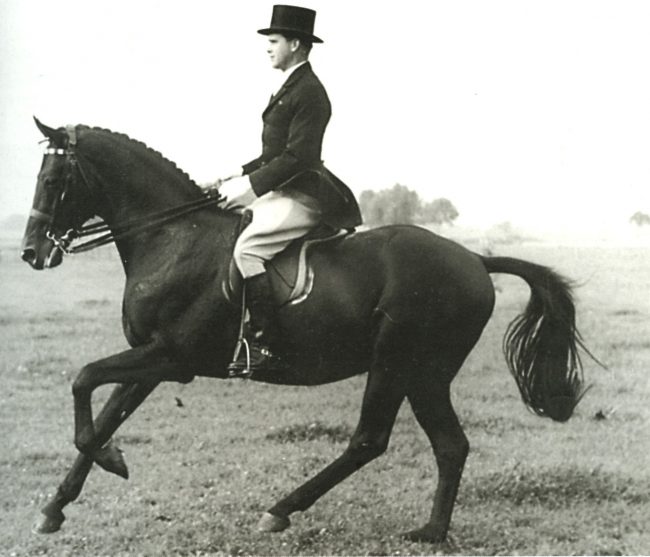
If Mr Schultheis came out and competed today would he look competitive or would he look old fashioned?
“Ok, everything develops, the whole sport developed, the breeding developed, but I still think those old masters would be the best ones. If you only see the pictures from 40 years ago and think, that’s only how they rode then, that’s a little unfair because it looks old fashioned. But they were so great they would ride today’s horses. Also if I see horses today, I see how much easier they make it for us.”
Today’s horses are easier because they’re better bred?
“Exactly. They have much more capacity, much more from the conformation, much more basic rideability. So for training it’s much easier than those old masters.”
So have you had to change your way of training much from the way that Mr Schultheis trained?
“I don’t think you change it too much, you go with the time, you want to be competitive, you look at what other ones are doing, you look at top level of the sport and you continue, I mean if you stand on your same level, it’s a step back, you always have to look forward and to think what’s new and to put new ideas in the whole system but not the basic way of riding.”
So it’s still the same?
“Yes, absolutely.”
And what are the new things?
“The new things for me are a lot of things with horsemanship, welfare of the horses, feeding of the horses, veterinarian points, it was harder to train the older horses, but we have now different problems. The horses back then were much harder than the horses are today. Maybe one reason is today’s horses have more capacity than the horses then, the strides are now higher, bigger, much more the cadence, and that is harder for the bones. Plus if you want to ride on a top level, you have to score around 75- 80% or more so these horses must be really on the limit of their possibilities. So we have little different problems to what they had, but in those times the horses has less movement so it was harder for them than it is today.”
“But the basic things like the schedule of training with the six points we have, the basics seat of a rider, the training of the rider, the training of the horse – these have not changed so much.”
Rudolf Zeilinger and Livijno
Breeding your own modern dressage star? Look at the range of top European Stallions available from IHB for the coming season. Go to www.ihb.com.au
Rock Springs
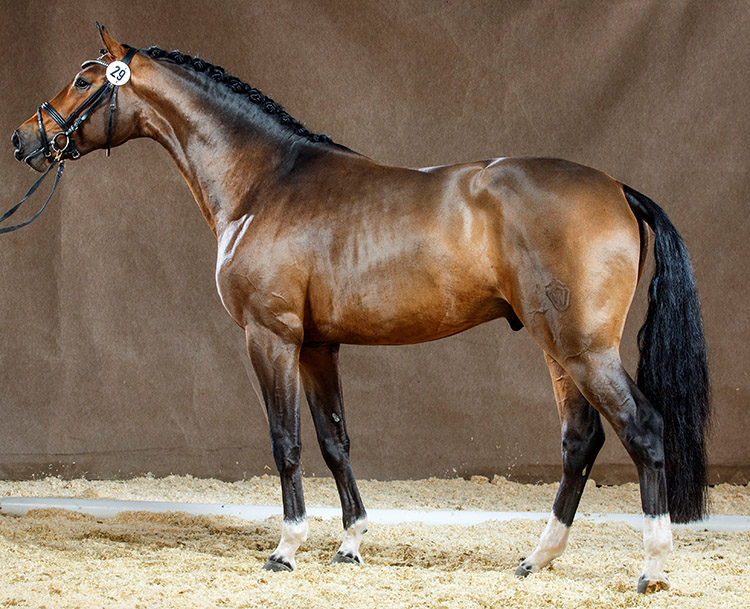
Finnigan
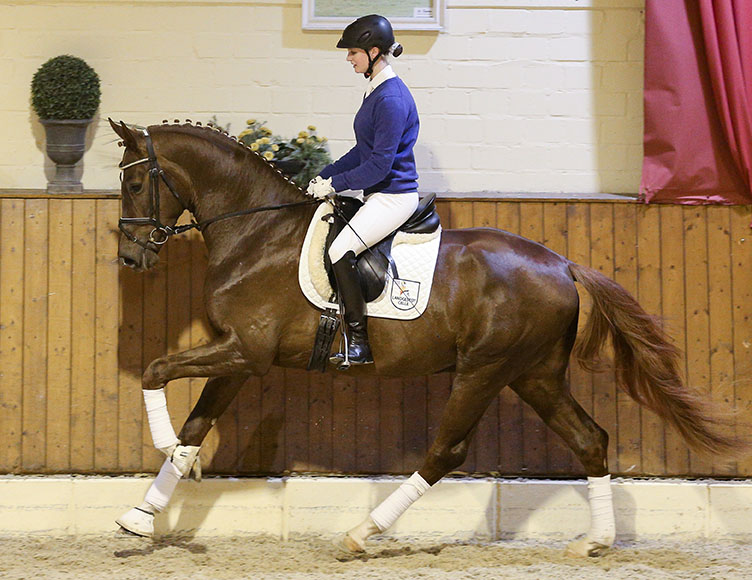
Escamillo
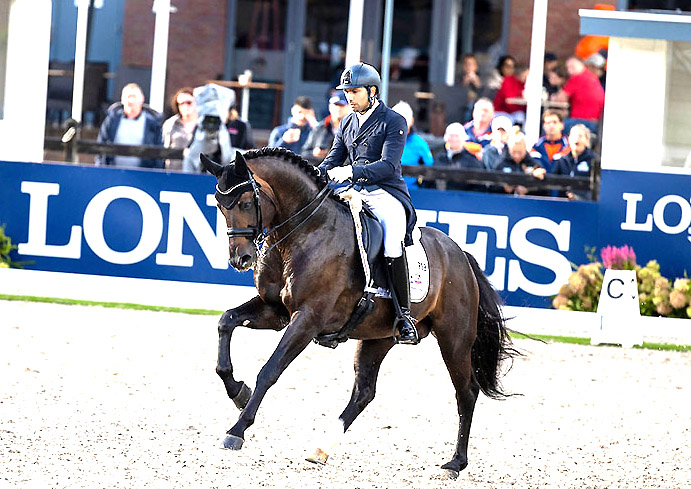




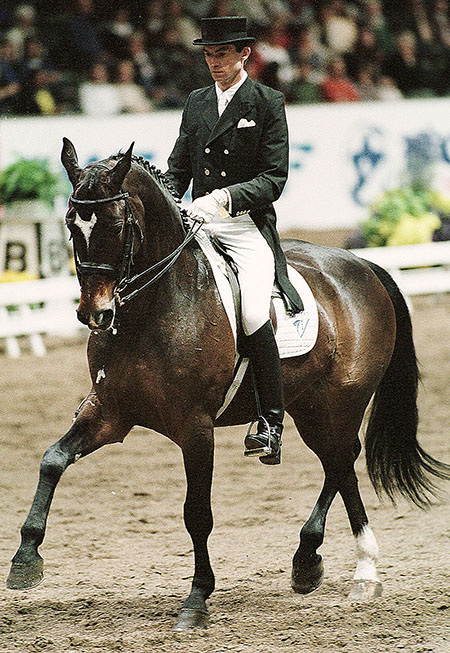
Lovely – through and through.